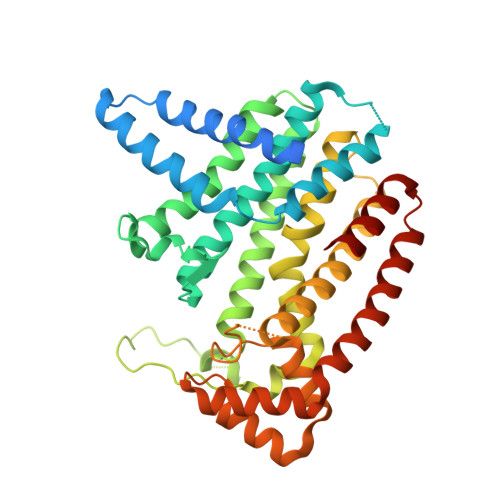Molecular characterization of a novel geranylgeranyl pyrophosphate synthase from Plasmodium parasites.
Artz, J.D., Wernimont, A.K., Dunford, J.E., Schapira, M., Dong, A., Zhao, Y., Lew, J., Russell, R.G., Ebetino, F.H., Oppermann, U., Hui, R.(2011) J Biol Chem 286: 3315-3322
- PubMed: 21084289
- DOI: https://doi.org/10.1074/jbc.M109.027235
- Primary Citation of Related Structures:
3LDW, 3MAV, 3PH7 - PubMed Abstract:
We present here a study of a eukaryotic trans-prenylsynthase from the malaria pathogen Plasmodium vivax. Based on the results of biochemical assays and contrary to previous indications, this enzyme catalyzes the production of geranylgeranyl pyrophosphate (GGPP) rather than farnesyl pyrophosphate (FPP). Structural analysis shows that the product length is constrained by a hydrophobic cavity formed primarily by a set of residues from the same subunit as the product as well as at least one other from the dimeric partner. Furthermore, Plasmodium GGPP synthase (GGPPS) can bind nitrogen-containing bisphosphonates (N-BPs) strongly with the energetically favorable cooperation of three Mg(2+), resulting in inhibition by this class of compounds at IC(50) concentrations below 100 nM. In contrast, human and yeast GGPPSs do not accommodate a third magnesium atom in the same manner, resulting in their insusceptibility to N-BPs. This differentiation is in part attributable to a deviation in a conserved motif known as the second aspartate-rich motif: whereas the aspartates at the start and end of the five-residue motif in FFPP synthases and P. vivax GGPPSs both participate in the coordination of the third Mg(2+), an asparagine is featured as the last residue in human and yeast GGPPSs, resulting in a different manner of interaction with nitrogen-containing ligands.
Organizational Affiliation:
Structural Genomics Consortium, University of Toronto, Toronto, Ontario M5G 1L7, Canada.















